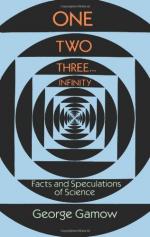|
This section contains 489 words (approx. 2 pages at 400 words per page) |

|
One Two Three . . . Infinity: Facts and Speculations of Science Summary & Study Guide Description
One Two Three . . . Infinity: Facts and Speculations of Science Summary & Study Guide includes comprehensive information and analysis to help you understand the book. This study guide contains the following sections:
This detailed literature summary also contains Topics for Discussion on One Two Three . . . Infinity: Facts and Speculations of Science by George Gamow.
"One, Two, Three. . . Infinity - Facts and Speculations of Science" by George Gamow is a work that is jam-packed with facts and information that cover in great detail the advancements man has made and the knowledge he has gained about himself, his world and his universe through the sciences of mathematics and physics.
The book opens with everyone's favorite subject: mathematics. The book contains a history of numbers that begins with how numbers came to be and how they were used in different societies. To the Hottentots in South Africa, numbers were almost meaningless - in fact they only related to and need three numbers. If someone asked a Hottentot tribesman with four or more children how many children he had, his response would be "many." But, of course, in most other cultures, the need arose for a workable numeric system. Roman numerals filled the bill for a time, however, the numerals were too cumbersome and a more proficient numeric system was adapted, the one that is still used today. From that innovation, math took off into many advanced disciplines including: the theory of abstract groups, non-commutable algebra, imaginary numbers, and non-Euclidian geometry.
The book explores the unusual properties of space and how it relates to man and earth. Advancements in math and geometry allowed man to begin the exploration of space without leaving earth. Man was able to devise ways to measure the distances between the earth and moon and the earth and the sun. The reader learns that our three-dimensional world could really be considered a four-dimensional world if the element of time is added to the mix. Discoveries by early physicists and astronomers gave modern scientists and astrophysicists the ability and tools to make major strides in the understanding of deep space and how relatively miniscule our planet really was.
The author does not limit his focus to the vastness and enigmatic nature of outer space. He delves into another unknown world that was much closer to home. Man became curious about the elements and chemicals that make up matter. Science looked deep into the unknown worlds of the atomic and subatomic and discovered the smallest particles in the universe and become to understand that everything, even the largest objects, were comprised of these tiny powerhouses. Man began to look inward and discovered what the differences were between inorganic and organic substances and what made something alive.
Finally, the author looks at the challenges that await man in deep space. Scientists have confirmed the existence of the billions of galaxies and stars in the skies and the planets, some like earth, that in all probability orbit around these distant planets where life as we know it is possible and even probable. The evolution of the sun and stars and ultimately the universe is discussed in great detail. The book appropriately ends on a note of mystery: Is the universe finite or infinite?
Read more from the Study Guide
|
This section contains 489 words (approx. 2 pages at 400 words per page) |

|



